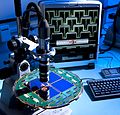Imachen:PIA17993-DetectorsForInfantUniverseStudies-20140317.jpg

Grandaria d'ista previsualización: 624 × 600 pixels. Atras resolucions: 250 × 240 pixels | 499 × 480 pixels | 799 × 768 pixels | 1065 × 1024 pixels | 2130 × 2048 pixels | 3000 × 2884 pixels.
Fichero orichinal (3000 × 2884 píxels; grandaria d'o fichero: 842 kB; tipo MIME: image/jpeg)
Historial d'o fichero
Punche en una calendata/hora ta veyer o fichero como amaneixeba por ixas envueltas.
| Calendata/Hora | Miniatura | Dimensions | Usuario | Comentario | |
|---|---|---|---|---|---|
| actual | 21:13 17 mar 2014 |  | 3000 × 2884 (842 kB) | Drbogdan | User created page with UploadWizard |
Uso d'o fichero
A pachina siguient emplega iste fichero:
Uso de fichers globals
Os siguients wikis fan servir iste fichero:
- Uso en ar.wikipedia.org
- Uso en az.wikipedia.org
- Uso en de.wikipedia.org
- Uso en en.wikipedia.org
- Uso en fa.wikipedia.org
- Uso en fr.wikipedia.org
- Uso en gl.wikipedia.org
- Uso en he.wikipedia.org
- Uso en hy.wikipedia.org
- Uso en it.wikipedia.org
- Uso en ka.wikipedia.org
- Uso en ko.wikipedia.org
- Uso en mk.wikipedia.org
- Uso en nn.wikipedia.org
- Uso en pl.wikipedia.org
- Uso en pl.wikinews.org
- Uso en pt.wikipedia.org
- Uso en ru.wikipedia.org
- Uso en ru.wikinews.org
- Uso en sv.wikipedia.org
- Uso en uk.wikipedia.org
- Uso en www.wikidata.org
- Uso en zh.wikipedia.org

